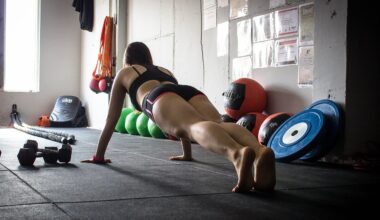Calisthenics Flexibility and Endurance: Stretching for Longer Workouts
When pursuing a journey in calisthenics, enhancing flexibility is vital for endurance and overall performance. Flexibility directly affects your ability to perform movements efficiently, allowing you to maintain proper form throughout your workout. Spending time stretching during your training helps improve blood circulation, reducing the risk of injuries while boosting muscle recovery. Engaging in a regular stretching routine influences not only your performance but also enhances your muscle’s elasticity over time. This improved elasticity contributes to achieving more complex movements as strength increases. Furthermore, flexibility training complements your strength-building workouts, optimizing your muscular coordination. Integrating stretches into your regimen is essential for maximizing your workout sessions and ensuring that each repetition maintains the highest quality possible. Specific stretches can target muscles used in calisthenics, ensuring they remain limber and functional. Additionally, focusing on long stretches can improve your physical and mental relaxation, making your workouts more enjoyable and effective. Incorporating these principles leads to longer workouts that are sustainable, beneficial, and successful in achieving fitness goals. This analysis will guide you through the significance of flexibility and stretching in calisthenics for endurance.
The Importance of Flexibility in Endurance Training
Flexibility plays a crucial role in endurance training within calisthenics. Without a sufficient range of motion, performing bodyweight exercises can quickly lead to improper form. This not only diminishes effectiveness but also increases the risk of injury over time. Long workouts require muscles to sustain their functionality across various movements. Therefore, flexibility directly influences your ability to transition between exercises smoothly. As a result, you can maintain a higher intensity throughout your training. When you start elevating your workout intensity, stiff muscles can lead to subpar performance levels. Over time, that can create frustration and stagnation in fitness progress. Gaining flexibility allows you to execute a broader variety of movements with more ease. Specifically, efforts can be placed on dynamic stretching, targeting areas that typically carry tension. Focusing on hip flexors, hamstrings, shoulders, and back can significantly improve your performance. Ultimately, improved flexibility enhances your endurance capabilities, making each training session more productive. Therefore, ensuring flexibility should be prioritized when crafting a balanced training program, as it leads to better strength gains and endurance.
Beyond performance benefits, flexibility training contributes to improved recovery time. Incorporating specific stretching routines post-workout is known to assist in muscle repair and reduce soreness. After undertaking rigorous calisthenics routines, muscles often need therapy to counteract tension. Focusing on lengthening muscles helps to alleviate any residual tightness, ensuring you remain active and ready for subsequent sessions. Targeted stretches can significantly enhance your workout cycle, allowing for quicker turnarounds between intense training days. Moreover, incorporating effective recovery techniques can make a substantial difference in overall stamina. Stretching contributes positively to your overall athletic longevity, permitting you to maintain high-performance levels for longer periods. This approach builds resilience against injuries, ensuring that your body adapts and modernizes along with your workout demands. As your flexibility improves, you may notice a transcendent boost not just in your workouts but also in daily physical activities, allowing for a more agile lifestyle overall. As such, you may find deeper engagement with your calisthenics training, ultimately leading to personal empowerment and satisfaction with functional fitness progress.
Dynamic vs. Static Stretching
Understanding the different styles of stretching is essential when implementing flexibility training for endurance. Dynamic stretching involves movement-based stretches that prepare muscles for activities by gradually increasing intensity. This type of stretching is especially valuable as a warm-up before launching into a calisthenics session. Modern research highlights how dynamic stretching better engages the nervous system, improving coordination and performance. In contrast, static stretching is conducted after workouts, focusing on extending individual muscles to enhance flexibility. Both approaches serve unique purposes, and incorporating a combination of the two in your routine is advisable. Typically, dynamic stretching should take place prior to workouts, while static stretches can be performed afterward for recovery and elongation. Implementing these variations promotes better muscle health and overall workout continuity, fostering endurance. When doing dynamic stretches, try exercises such as leg swings and arm circles to get the blood flowing effectively. Head into static stretches afterward with elements like seated toe touches and quad stretches to ensure muscle tension is released. This dual approach will not only improve flexibility but will set you up for long-lasting endurance success.
The science behind stretching techniques reveals insights into optimal training regimes. Gradually enhancing flexibility helps create a more comprehensive understanding of the body’s biomechanics during calisthenics. This understanding allows for a more tailored approach to personal workouts. Employing various stretching techniques, including contract-relax techniques, can also optimize muscle length and strength. Studies reveal that incorporating resourceful stretching mechanisms leads to impressive improvements in muscle performance. Experimenting with timing when incorporating stretches within your workout can drastically affect endurance levels; for instance, allowing time to warm up with dynamic techniques before immersing into actual bodyweight exercises creates sufficient muscle readiness. As you transition toward the completion of your workouts, switching to static stretches ensures optimal recovery. Implementing these strategies will help maximize endurance capabilities through improved flexibility and optimized movement patterns. Both stretching types complement each other, and alternating between them creates an ideal exercise mix for calisthenics enthusiasts wanting effective endurance training. Ultimately, understanding the science behind these techniques will provide better insights into maintaining long-term physical health—an ideal scenario for all fitness enthusiasts.
Best Stretches for Endurance in Calisthenics
Implementing effective stretching routines in calisthenics requires understanding what specific stretches yield the best results. Here are some recommended stretches that help facilitate greater flexibility and endurance. Start with the standing quadriceps stretch, targeting muscles fundamental to leg movements. This stretch can be performed with slight adjustments for comfort and effectiveness. Following that, consider hamstring stretches, important for maintaining cardiovascular efficiency and power in your workouts. Pigeon pose stretches are also excellent for hip flexibility, allowing deeper squats and lunges. Incorporating a cat-cow stretch can effectively warm up your back and spine, enhancing overall mobility. Include dynamic arm swings to loosen up shoulders and chest muscles, critical for upper-body endurance. Lastly, don’t overlook calf stretches; these can greatly help during leg-intensive calisthenics movements, preventing stiffness and ensuring optimal long-term performance. Incorporating this balanced approach to stretching will yield higher levels of endurance and functionality, which are essential in calisthenics. A consistent routine will not only improve your flexibility but also lead to efficient and fulfilling training experiences that empower you along your physical journey.
In conclusion, flexibility and endurance go hand in hand when it comes to calisthenics. Engaging in dedicated stretching routines enhances your physical capabilities and lessens injury risk. Moreover, knowing the significance of both dynamic and static stretching adds clarity and purpose, ensuring workouts are well-rounded and effective. Focusing on specific stretches helps tailor your routine and significantly boosts performance. Research supports that effective stretches lead to a more significant range of motion, essential for executing complex calisthenics movements. Emphasizing recovery through stretching post-workout fosters muscle adaptability and keeps workout enthusiasm high. With a mindful approach to movement and flexibility, incorporating both types of stretches builds resilience and endurance over time. Successful calisthenics requires a combination of strength, flexibility, and technique. Therefore, don’t overlook the role of flexibility; instead, understand its value in enhancing endurance and efficiency within your routine. By consistently integrating stretches and practices daily, you’ll notice profound improvements in your physical capabilities over time. Commit to this holistic perspective on flexibility, ultimately paving the way for lasting success in calisthenics.
This concludes our exploration of how calisthenics, through flexibility training, improves endurance. Remember to focus on targeted stretches to build an efficient and enjoyable workout program. Incorporating unique and effective routines will yield transformative results over time.


